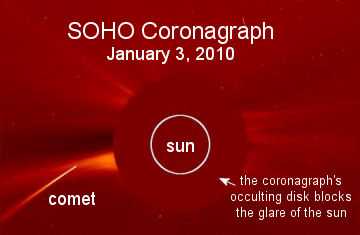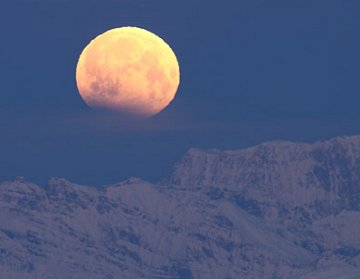NEWS Stefano!
What's up in Space What's up in Space
January 3, 2010 3 gennaio 2010
![]()
![]()
![]()
SATELLITE FLYBYS APP: Turn your iPhone or iPod into a field-tested satellite tracker! SATELLITE flyby APP: Trasforma il tuo iPhone o iPod in un campo-prova tracker satellite! Spaceweather.com presents the Satellite Flybys app . Spaceweather.com presenta le app Satellite Fly-by.
FIRST METEORS OF 2010: The annual Quadrantid meteor shower peaks on Jan. 3rd around 1900 UT (2 pm EST) when Earth passes through a stream of debris from shattered comet 2003 EH1. Meteore PRIMA DEL 2010: la meteora annuale Quadrantid doccia picchi su 3 gennaio 1900 UT (2 EST) quando la Terra passa attraverso un flusso di detriti della cometa in frantumi 2003 EH1. The timing favors observers in eastern Europe and Asia. I tempi favori osservatori in Europa orientale e in Asia. In North America, where the peak occurs in daylight, it may be possible to hear the shower on meteor radar. In Nord America, dove il picco si è verificato in pieno giorno, potrebbe essere possibile udire la doccia sul radar meteor. Tune into Space Weather Radio for live echoes. images: from James Beauchamp of Oklahoma City, OK Entrare in sintonia con Space Weather Radio di echi dal vivo. Immagini: da James Beauchamp di Oklahoma City, OK
DISINTEGRATING COMET: A bright comet discovered by NASA's STEREO-A spacecraft is swinging by the sun today and apparently disintegrating. Disintegrando COMET: Una cometa luminosa scoperto da STEREO NASA-A sonda si muove dal sole di oggi e apparentemente disintegrando. Click on the image to set the scene in motion: Clicca sull'immagine per impostare la scena in movimento:

Latest movies: gif , mpeg-4 , m4v Ultimi film: gif, mpeg-4, m4v
It will be interesting to see if a disembodied tail emerges from behind the coronagraph's occulting disk in the hours ahead. Sarà interessante vedere se una coda disincarnata emerge da dietro il disco di occultamento coronografo nella prossime ore.
This kamikaze comet is probably a member of the Kreutz sungrazer family. Questa cometa kamikaze è probabilmente un membro della famiglia sungrazer Kreutz. Named after a 19th century German astronomer who studied them in detail, Kreutz sungrazers are fragments from the breakup of a giant comet at least 2000 years ago. Il nome di un 19 ° secolo astronomo tedesco che ha studiato in dettaglio, sungrazers Kreutz sono frammenti dalla rottura di una cometa gigante di almeno 2000 anni fa. Several of these fragments pass by the sun and disintegrate every day. Molti di questi frammenti di passare dal sole e si disintegrano ogni giorno. Most are too small to see. La maggior parte sono troppo piccoli per vedere. Today's fragment is a big exception. Frammento di oggi è una grande eccezione.
Credit: The comet was found on Jan. 2nd by Australian amateur astronomer Alan Watson, who was inspecting images obtained by STEREO-A's Heliospheric Imager on Dec. 30, 2009. Di credito: La cometa è stata trovato il 2 gennaio da un astrofilo australiano Alan Watson, che stava ispezionando le immagini ottenute con STEREO-A Heliospheric Imager il 30 dicembre 2009.
BLUE MOON ECLIPSE: Blue moons--rare. BLUE MOON ECLIPSE: lune Blue - rare. Blue moons on New Year's Eve--really rare. A lunar eclipse of a Blue Moon on New Year's Eve--well, that's just ridiculous. Lune blu su New Year's Eve - davvero rara. Un'eclissi lunare di un Blue Moon su New Year's Eve - Beh, questo è solo ridicolo.
Yet that's exactly what happened on Dec. 31st in Europe, Asia, Africa and parts of Alaska. Eppure questo è esattamente ciò che è accaduto il 31 dicembre in Europa, Asia, Africa e l'Alaska. The Blue moon on New Year's Eve passed through the outskirts of Earth's shadow, producing this 8% lunar eclipse: La luna blu su New Year's Eve passata attraverso la periferia di ombra della Terra, a produrre questo 8% eclissi lunari:
"The eclipsed 'Blue moon' rose over the Alaska Range just before sunrise," says photographer Calvin Hall of Palmer, Alaska. "L'eclissi 'Blue moon' salito sopra la gamma Alaska poco prima dell'alba," dice il fotografo Calvin Hall di Palmer, Alaska. "It was a beautiful sight." "E 'stata una bella vista."
For the record, the average annual rate of blue Moons is 0.37 per year. Per la cronaca, il tasso medio annuo di Lune blu è 0,37 per anno. The rate of Blue moons on New Year's Eve is 0.05 per year. Il tasso di lune blu notte di Capodanno è di 0,05 euro all'anno. The rate of lunar eclipses of Blue moons on New Year's Eve is 0.01 per year. Il tasso di eclissi lunari di lune blu notte di Capodanno è di 0,01 euro all'anno. Click on the link below to browse a very rare gallery: Fare clic sul link sottostante per visualizzare una galleria molto raro:


Nessun commento:
Posta un commento